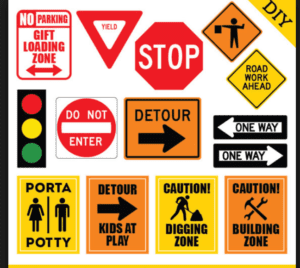NIGERIA ROAD SIGNS: If you went through a good driving school, you should be able to understand common road signs. You should know which speed is applicable on any road, you are expected to understand the warning and informative signs.
But we must admit that these road signs can be overwhelming at times. Most Nigerian drivers don’t even bother to read signs anymore hence the high risk of road accidents. Articles like this can save lives if only you can take time to go through it. The traffic sign is not a waste of time; they are there for your safety and that of others.
of road accidents. Articles like this can save lives if only you can take time to go through it. The traffic sign is not a waste of time; they are there for your safety and that of others.
Nigeria Road Signs and Symbols
Traffic signs tell you about traffic regulations, special hazards and other road conditions, construction areas speed limits, etc. The signs come with peculiar shapes and colors you should familiarize yourself with. Let’s look at the various types of signs and what they stand for.
- Regulatory Signs
They are mostly circular in shape and are of two types. Those with red and yellow circles are prohibitive signs. Those with blue circles but no red border are mandatory signs. They give positive instructions and are regulatory signs.
- Informative Signs
They are usually rectangular in shape and provide guidance information.
The stop sign is a prohibitive sign. It tells you to come to a complete stop before making another move. Proceed when it is safe to do so.
Warning Signs are usually triangular in shape, with a red perimeter. The only one warning sign with inverted triangle means to yield or give way.
- Regulatory Signs (Prohibitory)
- stop at an intersection;
- stop police • no left turn;
- no right turn;
- no “u” turn;
- overtaking prohibited;
- supplemented with road marking including ‘no change lane’;
- no entry for vehicles having axle load exceeding 8 metric tonnes;
- no entry for vehicles having an overall width exceeding 2m;
- no entry for lorries;
- no horns;
- speed limit (maximum);
- restriction sign;
- close to all vehicles in both directions;
- no entry to pedal cycles;
- no entry for all vehicles;
- no entry for vehicles having an overall height exceeding 3.5m;
- stop customs vehicles exceeding 12 metric tonnes laden load;
- stop customs;
- inscription varied to suit other obligations to stop;
- parking prohibited;
- 30 am to 5.30pm;
- no stopping;
- litter prohibited.
- Warning Signs
- a railway crossing with a gate;
- railway crossing without gate;
- supplementary intermediate level crossing;
- signs or countdown sign;
- general danger sign;
- “y” junction carriageway narrows;
- carriageway widens;
- narrow bridge;
- dangerous double bend (first to left);
- pedestrian crossing;
- children crossing;
- beware of animals;
- road work;
- blind people drive carefully;
- give way to the traffic on the right or give way to traffic on the left
- cross-road;
- “t” junction;
- “t” junction;
- “t” junction;
- “y” junction;
- “y” junction;
- long grade dangerous hill;
- dangerous bend right;
- dangerous bend left;
- dangerous double bend (first to right);
- roundabout;
- slippery surface;
- ferry;
- falling rocks;
- uneven road;
- loose chippings.
- Regulatory Signs (Mandatory) direction to be followed
- diversion;
- one way;
- roundabout;
- compulsory cycle track;
- pedestrian track;
- divided 2-lanes 2-way ahead;
- 2-lane-2 way ahead;
- 4-lanes undivided 2-way ahead;
- priority to approaching vehicle;
- two way;
- two way keep right;
- end diversion;
- pass either side;
- pedestrian track;
- speed limit (minimum);
- divided 4-lanes 2-way ahead;
- sign for temporary traffic control.
The Federal Road Safety Commission expects every driver to understand and take these signs seriously; failure to do so can result in a jail term, payment of fine or impoundment of your drivers’ license; apart from the obvious endangering of the lives of other road users.